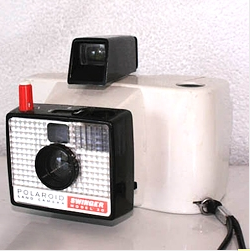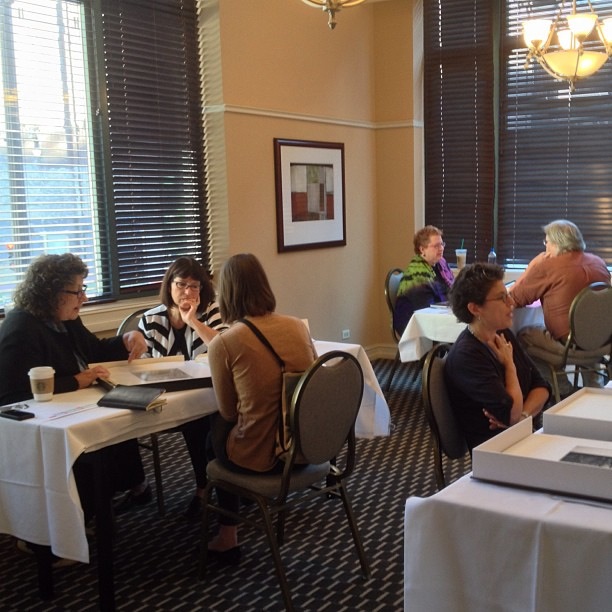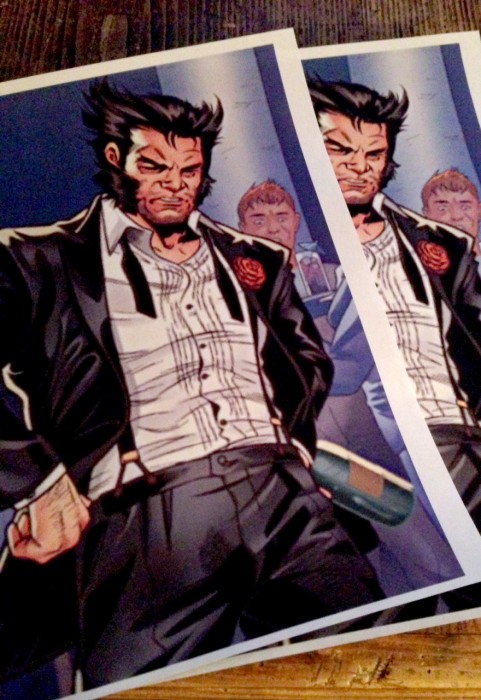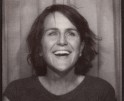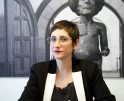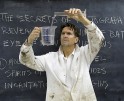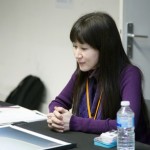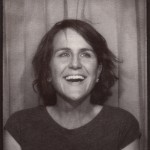The Paula Tognarelli Mixtape
If there was a Patron Saint of Photography it would undoubtedly be the one and only, the amazing Paula Tognarelli, Executive Director and Curator of the Griffin Museum of Photography. She has provided countless exhibition opportunities to countless photographers and has moved careers forward with her support. Currently the museum is featuring NINE exhibitions, three in the gallery, some at satillite spaces and on-line. Paula works tirelessly to champion photographers by traveling to review events around the country, by offering education, lectures, and opportunities for building community at the museum, by aligning with the Magenta Foundation’s Flash Forward Festival each Spring (this year from May 1-4th), and by hosting the annual Focus Awards that recognize individuals making critical contributions to the promotion, curation and presentation of photography. She has a terrific staff that helps her navigate the waters: Frances Jakubek, Associate Director, Meg Birnbaum, Director of Communications, Alison Nordström PhD, Consulting Curator of International Programs, Martha Stone, Gallery Monitor, Sarah Houston, Program Coordinator, and a host of volunteer interns. Paula manages to handle it all with grace, humor, and class.
I first met Paula almost a decade ago at the Photolucida Reviews. I was green and unprepared for the event, but her warmth and encouragement made me a fan for life. Over the years she has been a fairy godmother to me (and many, many others), offering me support, opportunities, and friendship. This year, I am incredibly honored to be selected as the The Griffin Museum of Photography’s 20th Juried Show: The Peter Urban Legacy Exhibition juror and hope you will consider submitting (the due date is March 31st, so hurry up!).
I would be remiss if I didn’t acknowledge Arthur Griffin in this celebration. The Griffin Museum opened in 1992 and “is the embodiment of founder Arthur Griffin’s passion — to promote an appreciation of photographic art and a broader understanding of its visual, emotional, and social impact. Arthur’s goal was to share with visitors his enthusiasm for a medium that is diverse, imaginative and informative.”
And now, it is with tremendous pleasure that I share The Paula Tognarelli Mixtape.
Tell us about your growing up and what brought you to photography.
My first camera was a Brownie Bullet Camera that I received for Christmas at age 7. I never put film in it though. I just pretended I knew what I was doing with it. Then in1965, I met the Swinger!
I really came to photography in 1997 in my career as a commercial printer. I was a senior executive in a large national commercial printing company and wanted to eliminate the scanning step in the manufacturing process to reduce costs. We acquired a photography business and brought the photographer on board along with his clients. We invested in a Leaf Camera. While we never eliminated the scanning step altogether we were very early adopters of an all-digital workflow. I, however, knew very little about running a photography business so I enrolled in the New England School of Photography Applied Program to learn all that I could about photography.
It wasn’t until 2003 that I arrived at the Griffin Museum of Photography. After September 11th, I looked at my life and decided to quit my corporate job in pursuit of the arts. I went back to school and got my Masters in Art Administration at Boston University. I did my internship at the Griffin and here I have stayed going on 11 years.
What is your title and job description and tell us about a typical day?
I am the executive director and curator for the Griffin Museum of Photography. My day is never typical and it never ends up the way I plan it to be. My day could be filled with meetings with donors, doing portfolio reviews for members, laying out and planning exhibits, writing grants, writing press releases or essays or analysis of one thing or another, producing financials, charts or budgets or WAIT for this very exciting item…. licking envelopes. I do what has to get done in the order of priority. I am not proud. You can bet that whatever I am doing all leads back to photography in one form or another and it always involves multitasking and some hocus pokus.
What are some of your proudest achievements?
I am proud of the satellite galleries that the Griffin has. It allows us to expand our reach and give exhibits to more photographers every year. We have four satellite galleries in addition to the three galleries at the main museum that all change about every two months. My thinking about the satellite galleries is that they help cross-pollinate audiences and market us outside of our community.
I also am very proud of the exhibition catalogs that we have produced for our exhibits at the Griffin. We do not do catalogs for every exhibit but we have done over 17 catalogs in a little over a year’s time. Meg Birnbaum designs all of the catalogs. We try to include more than just the body of work we are exhibiting. We offer the catalogs only through the museum in order to keep them as precious objects for the museum and the artists. On our website we allow a flip page view so the buyer knows what he/she is buying. You can find our catalogs here.
I am proud of the relationship I have with the Magenta Foundation and the Flash Forward Festival. MaryAnn Camilleri has been an incredible mentor to me.
I am also very proud of all of the photographers that we have exhibited and plan to exhibit. We have jumpstarted many photography careers. And the photographers have jumpstarted my career as well.
We are a forward thinking organization that tries to set its own pace and direction. We march to our own drum and I am so proud of that.
What do you look for when attending a portfolio review?
From the perspective of an educator is how I approach a portfolio review. While I am always pleased to find a body of work that I can showcase at the museum, my primary intent of going to a review event is to be of service. It is my opinion that this is my job as photography advocate. I want to understand what a photographer wants to accomplish and I want to help the photographer achieve that goal.
I am not at a review to impose my aesthetic on a photographer, but to help a photographer realize her/his own path. For example, I am not going to discourage a photographer from photographing what he/she loves to photograph even though it is a style of photography that has fallen out of favor with curators. I will make sure a photographer understands the realities of photographing certain subject matter. For example, when I first started to learn about how to photograph, my teachers said not to shoot ducks under any circumstances. Well, what if that is what a photographer wants to photograph? More than likely that work will not be exhibited at the Whitney but there are other opportunities for the duck lover and I try to help the photographer realize what those opportunities are.
As a curator for the Griffin Museum, I am not looking for work that appeals to my personal aesthetic. If I did that we would always be having the same exhibit over and over. I do, however, have a very broad aesthetic. I am looking for artists to exhibit that expose our audience to what is happening in photography today. I am looking for photography that fills certain voids in our schedule. For example, if I just exhibited a landscape exhibit, I would not immediately rush into securing another landscape exhibit until a considerable amount of time has passed.
It is my opinion that we as curators and gallerists have to have a bit of selflessness about us. It isn’t about who we are or what we are doing or what we want. It should be all about the artists, first and foremost. For me, at least, this is the type of arts advocate I want to be.
Any advice for photographers coming to a review event?
I would advise a photographer to know what it is he/she wants to accomplish at the reviews. Tell the reviewer what this is right up front, if the reviewer doesn’t ask. This way you are not wasting precious time.
The second thing I would advise is to get the work on the table fast. Do not talk and then show work. Talk while you are getting work on table. Again, 20 minutes is a very short time and you do not want to waste any of it.
Make sure that the overall body of work is edited to best tell the story you want to tell. Fifteen to twenty prints are good numbers to bring for a review. I also advise to bring multiple bodies of work. You want to be ready in case a reviewer does not respond to a body of work. You have another waiting in the wings. Number the back of the prints so you can recreate your edit for each reviewer. Sometimes there is not much time between reviews and this aid will help save time.
Bring a leave-behind that speaks to the work that you have just shown the reviewer. The reviewer sees so many photographers that more than likely she/he will not remember your name but will remember the images that you showed them. Put imagery (that you showed in the review) on your leave-behind.
Follow up after the review. Ask the reviewer if you can keep him/her apprised of your work and with what frequency. It is all about building relationships.
When you reflect on the reviews look for common messages that come through in reviews. Each reviewer will have a unique way of looking at work and it will be very confusing to follow every piece of advice. For example, one reviewer may want an image out of a sequence while another wants it in. Don’t go changing at the whim of reviewers. Reflect on what you heard from all the reviewers and make considered changes.
Make sure to have a website of your work so curators and gallerists can find your work after the reviews or in some cases before the reviews. If I have a list, in advance, of the photographers I will review, I go to their websites beforehand to see the work. Don’t miss out on this opportunity.
What is something unexpected that we don’t know about you?
I live a simple life.
Of course my world revolves around photography almost 24/7. If I am not at work surrounded by photography, I am at home surrounded by photography.
I have two dogs that I adore. Lucy is 15 years old and Gracie is 3. Lucy is a Jack Russell/Pointer mix from Puerto Rico. Gracie is a Sheltie/Mystery dog mix from Georgia. We are most comfortable in the woods where we can be off leash and can look under stones to find treasures beneath. We all live in Cambridge, MA outside of Harvard Square in an Irish Worker’s Cottage. We have a home in Provincetown, MA too when we need to get away from city life.
Since I was a kid I have collected comic books. The super hero and costumed crusader have always fascinated me. My favorite superheroes have been the Savage She Hulk, the Wolverine, Spiderman and Batman. I am open to any character that uses might for right.
At Halloween one year I told my mother I wanted to be Sir Walter Raleigh. My mother laughed, of course, but made my costume for me. I love her for that and I love that Sir Raleigh put his cape over the mud for the queen to step. In essence, SWR was my first super hero. Since then, I learned that this story of Raleigh is, alas, a myth.
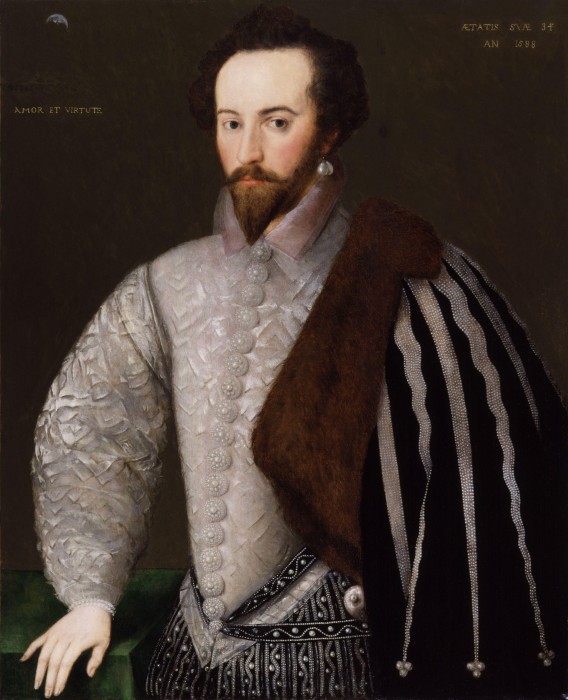
Portrait of Sir Walter Raleigh inscribed right: Aetatis suae 34 An(no) 1588 (“In the year 1588 of his age 34″) and left: with his motto Amore et Virtute (“By Love and Virtue”). National Portrait Gallery, London, NPG 7
I am a collector of photography books. In order to support my addiction, I rent a storage facility just to house them. If you’ve ever been to my office you know what I’m talking about. Serious but wonderful problem to have!
And since this is a mixtape, what is your favorite song, band, and do you dance?
What you may not know about me is that I have a bit of the introvert in me. My comfort zone doesn’t let me sing or dance in public but in my mind I am a rock star. Alone, I sing Katy Perry songs at the top of my lungs. I also am a fan of the operatic aria so although I don’t have a clue what it is I am singing, I enjoy to sing them as if I do. It is a great way to release emotions and a bit of heartache every now and then.
And now I take off the headphones and let Paula spin some tunes…..
I would like to share with the Lenscratch audience a bit about this year’s upcoming Griffin Museum’s Juried Exhibition that we are hosting and its call for entries. The deadline is March 31, 2014. This year our juried exhibition is juried by Aline Smithson. We have asked her to jury for between 50 and 60 images. There is no theme behind the exhibit. We also would like Aline to choose three awards. The awards are the Griffin Award, the Legacy Award and the Peter Urban Award. $500, $1000 and $2500.
This year’s exhibition is named after Peter Urban, a Boston photographer who died in 2009. Peter was a friend of the Griffin, was represented by Gallery Kayafas in the South End of Boston and was loved and missed by many. Through the Arts and Business Council and Peter’s family we are able to offer another award to our roster and are able to bring Aline Smithson to the opening reception and offer a lecture by her while she is here.
Thank you Paula, for all you do for photography and photographers!
Posts on Lenscratch may not be reproduced without the permission of the Lenscratch staff and the photographer.
Recommended
-
The Christy Karpinski MixtapeDecember 2nd, 2023
-
The Rotem Rozental MixtapeJanuary 27th, 2023
-
The Brian Taylor MixtapeJune 14th, 2019
-
The David Rosenberg MixtapeMay 3rd, 2019
-
The Jonathan Blaustein MixtapeJuly 20th, 2018



